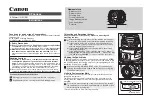
92
EN
Getting to know your camera better
8
Set
g
(Scene mode) to [
q
] (DIS MODE)
• As the ISO sensitivity increases automatically, you can hand hold the camera and take pictures
in low light situations with the flash off.
Increase the [ISO] setting
• Increase the value of the
[ISO]
setting. The image may become grainy.
g
“ISO
k
Setting the desired sensitivity to light” (P. 54)
The picture is too grainy
There are several factors that can cause the picture to appear grainy.
Increasing the ISO sensitivity
• When you increase the
[ISO]
setting,
“
noise
”
, which appears as spots of unwanted color or
unevenness in the color, can be introduced and give the picture a grainy appearance. This
camera is equipped with a function to allow shooting at high sensitivity while suppressing noise;
however, increasing the ISO sensitivity creates grainier pictures than when using a lower
sensitivity.
g
“ISO
k
Setting the desired sensitivity to light” (P. 54)
Image taken appears whitish
This may occur when the picture is taken in backlight or semi-backlight conditions. This is
due to a phenomenon called flare or ghost. As far as possible, consider a composition where
strong light source is not taken in the picture. Flare may occur even when a light source is not
present in the picture. Use a lens hood to shade the lens from the light source. If a lens hood
does not have effect, use your hand to shade the lens from the light.
Taking pictures with the correct color
The reason why there are differences between the colors in a picture and the actual colors
taken and the actual color is the light source illuminating the subject.
[WB]
is the function that
allows the camera to determine the correct colors. Normally, the
[AUTO]
setting provides the
optimal white balance, but depending on the subject, it may be better to experiment with
changing the
[WB]
setting.
• When the subject is in the shade on a sunny day
• When the subject is illuminated by both natural light and indoor lighting, such as when near a
window
• When there is no white in the frame
g
“White balance
k
Adjusting the color tone” (P. 54)
Taking pictures of a white beach or snow scene
In normal cases, white subjects such as snow will appear darker than usual when the picture
is taken. There are several ways to capture the whiteness.
• Adjust the exposure compensation toward
[+]
.
g
“Exposure compensation
k
Varying the
image brightness” (P. 53)
• Use
[
g
]
(BEACH & SNOW) in
g
(Scene mode) to take the picture. It is most suitable for
taking pictures of the sea in a sunny day or snow-capped mountains.
g
“Scene mode” (P. 29)
• Use
[
n
HI]
(Highlight control).
Press the shutter button halfway at the center of the viewfinder where you wish to highlight the
whiteness. The metered part at the center will be set to appear whiter.
g
“Metering mode
k
Changing the metering system” (P. 52)
• Use the auto bracketing function to take the picture.
If you do not know the amount of exposure compensation, try using auto bracketing. The
compensation value changes a little every time you press the shutter button. If you set a larger
exposure compensation, you can change the compensation value either upwards or downwards
based on that value and shoot the picture.
g
“AE bracketing” (P. 35)
s0013_e_00_unified.book Page 92 Monday, March 5, 2007 10:04 AM
Содержание E-410 - EVOLT Digital Camera SLR
Страница 132: ...Printed in China VH885101...
















































